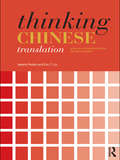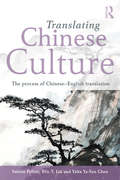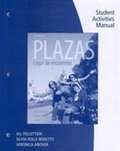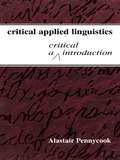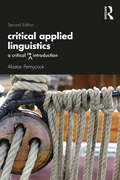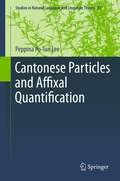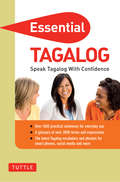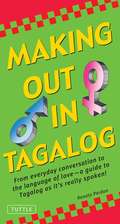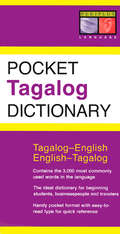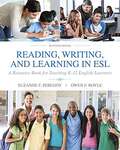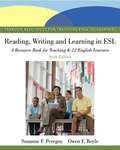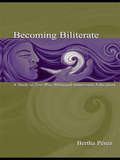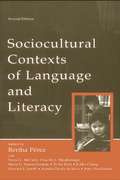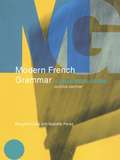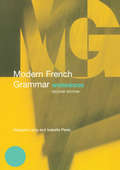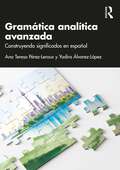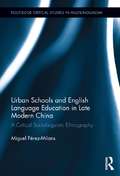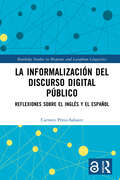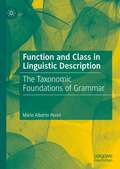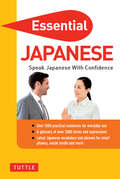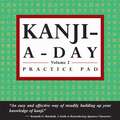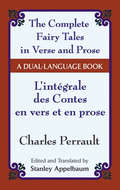- Table View
- List View
Thinking Chinese Translation: Chinese to English
by Valerie Pellatt Eric T. LiuThinking Chinese Translation is a practical and comprehensive course for advanced undergraduates and postgraduate students of Chinese. Thinking Chinese Translation explores the ways in which memory, general knowledge, and creativity (summed up as ‘schema’) contribute to the linguistic ability necessary to create a good translation. The course develops the reader’s ability to think deeply about the texts and to produce natural and accurate translations from Chinese into English. A wealth of relevant illustrative material is presented, taking the reader through a number of different genres and text types of increasing complexity including: technical, scientific and legal texts journalistic and informative texts literary and dramatic texts. Each chapter provides a discussion of the issues of a particular text type based on up-to-date scholarship, followed by practical translation exercises. The chapters can be read independently as research material, or in combination with the exercises. The issues discussed range from the fine detail of the text, such as punctuation, to the broader context of editing, packaging and publishing translations. Major aspects of teaching and learning translation, such as collaboration, are also covered. Thinking Chinese Translation is essential reading for advanced undergraduate and postgraduate students of Chinese and translation studies. The book will also appeal to a wide range of language students and tutors through the general discussion of the principles and purpose of translation.
Translating Chinese Culture: The process of Chinese--English translation
by Valerie Pellatt Eric T. Liu Yalta Ya-Yun ChenTranslating Chinese Culture is an innovative and comprehensive coursebook which addresses the issue of translating concepts of culture. Based on the framework of schema building, the course offers helpful guidance on how to get inside the mind of the Chinese author, how to understand what he or she is telling the Chinese-speaking audience, and how to convey this to an English speaking audience. A wide range of authentic texts relating to different aspects of Chinese culture and aesthetics are presented throughout, followed by close reading discussions of how these practices are executed and how the aesthetics are perceived among Chinese artists, writers and readers. Also taken into consideration are the mode, audience and destination of the texts. Ideas are applied from linguistics and translation studies and each discussion is reinforced with a wide variety of practical and engaging exercises. Thought-provoking yet highly accessible, Translating Chinese Culture will be essential reading for advanced undergraduates and postgraduate students of Translation and Chinese Studies. It will also appeal to a wide range of language studies and tutors through its stimulating discussion of the principles and purposes of translation.
Plazas Student Activities Manual: Lugar de encuentros, Fourth Edition
by Jill Pellettieri Silvia Rolle-Rissetto Veronica AnoverThe Plazas Workbook has been written and designed to accompany the Plazas textbook and contains activities targeted at vocabulary and grammar building, critical skills and strategies necessary for the comprehension and production of written texts.
A History of the Spanish Language
by Ralph PennyThis is a thoroughly revised, updated and expanded edition of Ralph Penny's authoritative textbook, first published in 1991, which provides a clear and elegant account of the development of Spanish over the last 2,000 years. Although principally oriented towards 'internal' history, 'external' history is also considered and referred to throughout. In this new edition, as well as adding insights from recent scholarship throughout the text, Professor Penny has added a new chapter which discusses the nature of linguistic history, the concept of World Spanish, processes of convergence and divergence in Spanish, and the English/Spanish interface. This edition also contains a glossary of technical terms, guidance on further reading, and suggested topics for discussion.
Critical Applied Linguistics: A Critical Introduction
by Alastair PennycookThis accessible guide and introduction to critical applied linguistics provides a clear overview, highlighting problems, debates, and competing views in language education, literacy, discourse analysis, language in the workplace, translation and other language-related domains. Covering both critical theory and domains of practice, the book is organized around five themes: the politics of knowledge, the politics of language, the politics of texts, the politics of pedagogy, and the politics of difference. It is an important text for anyone involved in applied linguistics, TESOL, language education, or other language-related fields.
Critical Applied Linguistics: A Critical Re-Introduction
by Alastair PennycookNow in its second edition, this accessible guide and introduction to critical applied linguistics provides a clear overview of the problems, debates, and competing views in language education, literacy, discourse analysis, language in the workplace, translation, and other language-related domains. Covering both critical theory and domains of practice, the book is organized around five themes: the politics of knowledge, the politics of language, the politics of difference, the politics of texts, and the politics of pedagogy. Recognizing that a changing world requires new ways of thinking, and that many approaches have watered down over time, the new edition applies a sharp, fresh look at established and new intellectual frameworks. The second edition is comprehensively updated with additional research throughout and features new discussions of colonialism, queer theory, race and gender, translanguaging, and posthumanism. With a critical focus on the role of applied linguists, Pennycook emphasizes the importance of a situated, collaborative perspective that takes the discussion away from questions of implementation, and insists instead that critical applied linguistics has to be an emergent program from the contexts in which it works. This landmark text is essential reading for students and researchers of applied linguistics, multilingualism, language and education, TESOL, and language and identity.
Cantonese Particles and Affixal Quantification (Studies in Natural Language and Linguistic Theory #87)
by Peppina Po-lun LeeCantonese, the lingua franca of Hong Kong and its neighboring province, has an unusually rich repertoire of verbal particles. This volume significantly augments the academic literature on their semantics, focusing on three affixal quantifiers, -saai, -hoi and -maai. The author shows how these verbal suffixes display a unique interplay of syntax and semantics: used in a sentence with no focus, they quantify items flexibly, according to an accessibility hierarchy; with focus, focus comes into effect after syntactic selection. This fresh and compelling perspective in the study of particles and quantification is the first in-depth analysis of Cantonese verbal suffixes. It compares the language's affixal quantification to the alternative determiner and adverbial quantifiers. The book's syntax-semantics mapping geography deploys both descriptive and theoretical approaches, making it an essential resource for researchers studying the nexus of syntax and semantics, as well as Cantonese itself.
Essential Tagalog
by Renato PerdonStart speaking Tagalog today with Essential Tagalog! This easy phrase book gives you all the words and phrases you need in the Philippines or Tagalog-speaking environments. Even with no prior experience speaking Tagalog, you'll find everything you need in this simple guide:Easy to understand pronunciation notesOver 1,500 essential Tagalog sentences and phrases needed in everyday interactions in restaurants and shops, at work, in a doctor's office, or with friendsA glossary of 2,000 key words and phrases, including words for smart phones, the internet, social networking, and more!Special etiquette notes to help you make perfect first impressions and avoid awkward mistakesA short grammar overview that shows you how to make your own sentences and questionsLearn Tagalog today! It's easy!
Making Out in Tagalog: (Tagalog Phrasebook)
by Renato PerdonMaking Out in Tagalog is a fun, accessible and thorough Tagalog phase book and guide to the Filipino language as it's really spoken.<P><P>If you are a student, businessman or tourist traveling to the Philippines and would like to have an authentic and meaningful experience, the key is being able to speak like a local. This friendly and easy-to-use Tagalog phrasebook makes this possible. Making Out in Tagalog has been carefully designed to act as a guide to modern colloquial Tagalog for use in everyday informal interactions-giving access to the sort of catchy Filipino expressions that aren't covered in traditional language materials. Each expression is given in Tagalog, so that in the case of difficulties the book can be shown to the person the user is trying to communicate with.This Tagalog phrasebook includes:A guide to pronouncing Tagalog words correctly including vowel combinations and stressing of wordsExplanations of basic Tagalog grammar, such as, word order, pronouns, borrowed words, and polite vs. impolite tensesUseful and interesting notes on Tagalog language and Filipino cultureLots of colorful, fun and useful expressions not covered in other phrasebooks
Pocket Tagalog Dictionary
by Renato PerdonThis is a pocket sized Tagalog (Filipino) DictionaryIntended for use by tourists, students, and business people traveling to The Philippines Pocket Tagalog Dictionary is an essential tool for communicating in Tagalog. It features all the essential Tagalog vocabulary appropriate for beginning to intermediate students. It's handy pocket format and easy-to read type will make any future trip to The Philippines much easier. In addition to being an excellent English to Tagalog dictionary and Tagalog to English dictionary Pocket Tagalog Dictionary contains important notes on the Tagalog language, Tagalog grammar and Tagalog pronunciation. All Filipino words are written in English and Tagalog so that in the case of difficulties the book can simply be shown to the person the user is trying to communicate with.This dictionary contains:The 3,000 most commonly used words in the Tagalog languageAn introduction to and history of the Tagalog languageInformation on Tagalog grammarA guide to pronouncing Tagalog correctlyOther books from this bestselling series you might enjoy are: Pocket Vietnamese Dictionary, Pocket Cambodian Dictionary, Pocket Thai Dictionary, Pocket Indonesian Dictionary, and Pocket Malay Dictionary.
Pocket Tagalog Dictionary
by Renato PerdonThis is a pocket sized Tagalog (Filipino) DictionaryIntended for use by tourists, students, and business people traveling to The Philippines Pocket Tagalog Dictionary is an essential tool for communicating in Tagalog. It features all the essential Tagalog vocabulary appropriate for beginning to intermediate students. It's handy pocket format and easy-to read type will make any future trip to The Philippines much easier. In addition to being an excellent English to Tagalog dictionary and Tagalog to English dictionary Pocket Tagalog Dictionary contains important notes on the Tagalog language, Tagalog grammar and Tagalog pronunciation. All Filipino words are written in English and Tagalog so that in the case of difficulties the book can simply be shown to the person the user is trying to communicate with.This dictionary contains:The 3,000 most commonly used words in the Tagalog languageAn introduction to and history of the Tagalog languageInformation on Tagalog grammarA guide to pronouncing Tagalog correctlyOther books from this bestselling series you might enjoy are: Pocket Vietnamese Dictionary, Pocket Cambodian Dictionary, Pocket Thai Dictionary, Pocket Indonesian Dictionary, and Pocket Malay Dictionary.
Reading, Writing, and Learning in ESL: A Resource Book for Teaching K-12 English Learners
by Suzanne Peregoy Owen BoyleThis book is the ideal source for teaching oral language, reading, writing, and the content areas in English to K-12 English learners. In an approach unlike most other books in the field, Reading, Writing, and Learning in ESL looks at contemporary language acquisition theory as it relates to instruction and provides detailed suggestions and methods for motivating, involving, and teaching English language learners. Praised for its strong research base, engaging style, and inclusion of specific teaching ideas, the book offers thorough coverage of oral language, reading, writing, and academic content area instruction in English for K-12 English learners. Thoroughly updated throughout, the new edition includes a new chapter on using the Internet and other digital technologies to engage students and promote learning, many new teaching strategies, new and revised activities, and new writing samples.
Reading, Writing, and Learning in ESL: A Resource Book for Teaching K-12 English Learners (6th Edition)
by Suzanne F. Peregoy Owen F. BoyleReading, Writing, and Learning in ESL: A Resource Book for Teaching K-12 English Learners, Sixth Edition, is a comprehensive, reader-friendly resource book that provides a wealth of teaching ideas for promoting oral language, reading, and writing development in English for K-12 English learners. The book provides up-to-date language acquisition theory, classroom organization, teaching strategies, and assessment procedures for effective English learner instruction.
The Indo-European Controversy
by Pereltsvaig, Asya and Lewis, Martin W. Asya Pereltsvaig Martin W. LewisOver the past decade, a group of prolific and innovative evolutionary biologists has sought to reinvent historical linguistics through the use of phylogenetic and phylogeographical analysis, treating cognates like genes and conceptualizing the spread of languages in terms of the diffusion of viruses. Using these techniques, researchers claim to have located the origin of the Indo-European language family in Neolithic Anatolia, challenging the near-consensus view that it emerged in the grasslands north of the Black Sea thousands of years later. But despite its widespread celebration in the global media, this new approach fails to withstand scrutiny. As languages do not evolve like biological species and do not spread like viruses, the model produces incoherent results, contradicted by the empirical record at every turn. This book asserts that the origin and spread of languages must be examined primarily through the time-tested techniques of linguistic analysis, rather than those of evolutionary biology.
Becoming Biliterate: A Study of Two-Way Bilingual Immersion Education
by Bertha PerezThis book describes the development process and dynamics of change in the course of implementing a two-way bilingual immersion education program in two school communities. The focus is on the language and literacy learning of elementary-school students and on how it is influenced by parents, teachers, and policymakers. Pérez provides rich, highly detailed descriptions, both quantitative and qualitative, of the change process at the two schools involved, including student language and achievement data for five years of program implementation that were used to test the basic two-way bilingual theory, the specific school interventions, and the particular classroom instructional practices. The contribution of Becoming Biliterate: A Study of Two-Way Bilingual Immersion Education is to provide a comprehensive description of contextual and instructional factors that might help or hinder the attainment of successful literacy and student outcomes in both languages. The study has broad theoretical, policy, and practical instructional relevance for the many other U.S. school districts with large student populations of non-native speakers of English. This volume is highly relevant for researchers, teacher educators, and graduate students in bilingual and ESL education, language policy, linguistics, and language education, and as a text for master's- and doctoral-level classes in these areas.
Sociocultural Contexts of Language and Literacy
by Bertha Pérez Teresa L. McCarty Lucille J. Watahomigie To Thi Dien Ji-Mei Chang Howard L. Smith Aurelia Dávila Amy NordlanderSociocultural Contexts of Language and Literacy, Second Edition engages prospective and in-service teachers in learning about linguistically and culturally diverse students, and in using this knowledge to enrich literacy learning in classrooms and communities. The text is grounded in current research and theory that integrate sociocultural and constructivist concepts and perspectives and provide a framework teachers can use to develop strategies for teaching reading, writing, and thinking to diverse students. The focus on English literacy development does not imply advocacy for "English only" or ESL as the primary mode of literacy instruction. Rather, the authors take the position that learners need to develop literacy in their native language and that the concepts and skills learned in developing the native language create a foundation of strength from which students can develop English literacy. Part I introduces relevant research and language learning theories. Part II provides research reviews and information about literacy learning within specific culturally and linguistically diverse communities. The chapters in Part III challenge the reader to view the multiple social, intellectual, cultural, and language differences children bring to the classroom as an opportunity for learning and building on the diversity among students. Activities and suggested readings at the end of each chapter involve readers in reflection, observation, meaning making, and the construction of application processes for their new understandings. New in the Second Edition:*updated research and theory on multilingual and second language literacy;*a focus on the interpretation of these research findings to make them useful for teachers and teacher educators in understanding and articulating the research bases for literacy practices; *attention to current intensely debated issues, such as standards, the phonics movement, and high-stakes testing; and*new activities and suggested readings.
Modern French Grammar: A Practical Guide (Modern Grammars)
by Isabelle Perez Margaret LangThis new edition of the Modern French Grammar is an innovative reference guide to French, combining traditional and function-based grammar in a single volume. Divided into two parts, Part A covers traditional grammatical categories such as word order, nouns, verbs and adjectives and Part B is organized around language functions and notions such as: giving and seeking information describing processes and results expressing likes, dislikes and preferences. With a strong emphasis on contemporary usage, all grammar points and functions are richly illustrated with examples. Implementing feedback from users of the first edition of the Grammar, this second edition includes clearer explanations and greater emphasis on areas of particular difficulty for learners of French. This is the ideal reference grammar for learners of French at all levels, from beginner to advanced. No prior knowledge of grammatical terminology is assumed and a glossary of grammatical terms is provided. This Grammar is complemented by the Modern French Grammar Workbook Second Edition which features related exercises and activities.
Modern French Grammar Workbook (Modern Grammar Workbooks)
by Isabelle Perez Margaret LangModern French Grammar Workbook, second edition, is an innovative book of exercises and language tasks for all learners of French. The book is divided into two sections:* section 1 provides exercises based on essential grammatical structures* section 2 practises everyday functions (e.g. making introductions, apologizing, expressing needs).A comprehensive answer key at the back of the book enables you to check your progress. Taking into account feedback from the first edition, this second edition now features:* exercises graded on a 3-point scale according to their level of difficulty* cross-referencing to the Modern French Grammar, Second Edition, for each and every exercise* topical exercises that develop vocabulary.Modern French Grammar Workbook is ideal for all learners of French: beginners, intermediate and advanced students. It can be used both independently and alongside the Modern French Grammar (ISBN 0-415-33162-5).
Gramática analítica avanzada: Construyendo significados en español (Analytic Grammars for Advanced Learners and Teachers)
by Ana Teresa Pérez-Leroux Yadira Álvarez-LópezLa Gramática analítica avanzada: Construyendo significados en español ofrece una cobertura descriptiva amplia de los temas gramaticales fundamentales del español, a la vez que proporciona un tratamiento detallado de las estrategias de análisis necesarias para que los lectores puedan desarrollar sus destrezas analíticas y su propio pensamiento gramatical. Esta gramática no asume conocimiento previo de la lingüística. Para ayudar al lector, los materiales están organizados desde los conceptos más básicos a los más complejos. Las herramientas analíticas que acompañan los diferentes temas pueden aplicarse a nuevos fenómenos que surjan durante el proceso de aprendizaje del español como segunda lengua, ofreciéndoles a los lectores la garantía de poder seguir aprendiendo. Cada capítulo contiene una síntesis, tablas de resumen y ejercicios que sirven para repasar los conceptos estudiados.La Gramática analítica avanzada será de utilidad tanto para los estudiantes avanzados de español como segunda lengua que busquen profundizar su comprensión de la gramática del español, así como para hablantes nativos y futuros maestros que deseen reforzar su conocimiento de los fundamentos de la gramática descriptiva.Gramática analítica avanzada: Construyendo significados en español provides a comprehensive descriptive coverage of core grammatical topics in the Spanish language while simultaneously offering an in-depth analytic treatment to support readers in developing their own grammatical thinking.This grammar assumes no previous familiarity with linguistics and organizes the materials from the more basic to more complex concepts to help readers understand the building blocks of the language. The analytic toolkit provided for the topics covered within the book can be applied to novel phenomena encountered in the second language acquisition process, setting readers up for lifelong independent learning. Each chapter includes a chapter summary, summary tables, and exercises to reinforce and review the concepts covered.Gramática analítica avanzada will be useful to advanced speakers of Spanish as a second language seeking to deepen their conscious understanding of Spanish grammar as well as native speakers and future teachers who wish to strengthen their foundational knowledge of descriptive grammar.
Urban Schools and English Language Education in Late Modern China: A Critical Sociolinguistic Ethnography (Routledge Critical Studies in Multilingualism)
by Miguel Perez-MilansShortlisted for the 2014 BAAL Book Prize This book explores the meaning of modernization in contemporary Chinese education. It examines the implications of the implementation of reforms in English language education for experimental-urban schools in the People’s Republic of China. Pérez-Milans sheds light on how national, linguistic, and cultural ideologies linked to modernization are being institutionally (re)produced, legitimated, and inter-personally negotiated through everyday practice in the current context of Chinese educational reforms. He places special emphasis on those reforms regarding English language education, with respect to the economic processes of globalization that are shaping (and being shaped by) the contemporary Chinese nation-state. In particular, the book analyzes the processes of institutional categorization of the "good experimental school", the "good student", and the "appropriate knowledge" that emerge from the daily discursive organization of those schools, with special attention to the related contradictions, uncertainties and dilemmas. Thus, it provides an account of the on-going cultural processes of change faced by contemporary Chinese educational institutions under conditions of late modernity. Winner of The University of Hong Kong's Faculty Early Career Research Output Award for outstanding book publication, by the Faculty of Education
La informalización del discurso digital público: Reflexiones sobre el inglés y el español (Routledge Studies in Hispanic and Lusophone Linguistics)
by Carmen Pérez-SabaterLa informalización del discurso digital público is an innovative volume which examines different communicative practices which take place on social media and justifies the shift towards more informal/oral styles of public communication in English and Spanish.The book takes a first step in understanding and analysing how the use of code-switching, language preference, and graphicons contribute to the public image of institutions, politicians and celebrities, as well as how the aforementioned strategies fit into the negotiation of the norms and identities of public communities on social media platforms. Offering an updated approach to studying digital discourse in public contexts, it is the first of its kind written in Spanish. The volume focuses on the characteristic linguistic features associated with digital communication and informal oral writing styles, such as reduplication of vowels, consonants, acronyms, and shortenings, code-switching and language preference, and the insertion of multimodal and graphical elements.A comprehensive and unique volume, La informalización del discurso digital público is ideal for researchers and postgraduate students interested in digital discourse, sociolinguistics, and media studies.Chapter 5 of this book is freely available as a downloadable Open Access PDF at http://www.taylorfrancis.com under a Creative Commons Attribution-Non Commercial-No Derivatives (CC-BY-NC-ND) 4.0 license.La informalización del discurso digital público es un volumen innovador que examina diferentes prácticas comunicativas que tienen lugar en las redes sociales con el fin de justificar el cambio hacia estilos más informales/orales de comunicación pública en inglés y en español.El libro ofrece un punto de vista novedoso sobre la contribución del cambio de código, la elección de lengua y los graficonos a la imagen pública de instituciones, políticos y celebridades; así como la repercusión que las estrategias mencionadas tienen en la negociación de las normas e identidades de las comunidades públicas en redes sociales. Ofrece un enfoque actualizado del estudio del discurso digital en contextos públicos y es el primero de este tipo escrito en español. El volumen se centra en los rasgos lingüísticos característicos de la comunicación digital y de los estilos de escritura oral informal, tales como la reduplicación de vocales, consonantes, acrónimos y abreviaturas, el cambio de código y la preferencia de lengua, así como la inserción de elementos multimodales y gráficos.La informalización del discurso digital público es un volumen completo y único, ideal para investigadores y estudiantes de posgrado interesados en el discurso digital, la sociolingüística y los estudios sobre los medios de comunicación.Chapter 5 of this book is freely available as a downloadable Open Access PDF at http://www.taylorfrancis.com under a Creative Commons Attribution-Non Commercial-No Derivatives (CC-BY-NC-ND) 4.0 license.
Function and Class in Linguistic Description: The Taxonomic Foundations of Grammar
by Mário Alberto PeriniThis book deals with the traditional problem of the classification of linguistic units, with a primary focus on word classes. The approach is descriptive rather than theoretical, and is based on the use of distinctive features analogous to the ones used in phonology, which entails a radical reworking of the traditional classification. The first part presents some basic notions such as the use of distinctive features and the role of word classes in grammar; classification by prototypes; and the use of world knowledge as a resource to assign thematic relations to constituents in the sentence. In the second part, some descriptive problems are examined, namely the classification of verbs according to valency; connectives, adverbs, and the internal constituents of the NP; and the classification of units larger than words. This book will be of use as a guide for linguists working on the description of natural languages, as well as a resource for students on courses in linguistic theory and description.
Essential Japanese
by Periplus EditorsA concise Japanese phrase book and guide to Japanese language, Essential Japanese contains basic vocabulary necessary for communicating in Japanese.Essential Japanese is a great first introduction and phrasebook for the Japanese language. Perfect for business people or tourist traveling to Japan or for students who want to supplement their learning (and get an A in Japanese!), this book's easy indexing feature allows it to act as a Japanese phrasebook or as a Japanese to English Dictionary / English to Japanese Dictionary. All words and phrases are also written in Japanese Kanji and Kana (hiragana and katakana). A clever "point to" feature allows you to simply point to a phrase translated in Japanese without the need to say a word. You will soon find yourself turning to Essential Japanese again and again when visiting Japan and working or interacting with Japanese speakersIn this book you will find:Over 1500 practical sentences for everyday useA glossary of over 200 terms and expressionsLatest Japanese vocabulary and Japanese phrases for smart phones, social media and moreJapanese characters (kana and kanji) as well as Latin script (romanji)
Kanji-A-Day Practice Pad Volume 2
by Periplus Editors"An easy and effective way of steadily building up your kanji."-Kenneth G. Henshall, A Guide to Remembering Japanese CharactersThis calendar-like practice pad allows you to effectively practice basic-intermediate Japanese kanji and learn a year's wroth of kanji in just minutes a day.Although more people are studying the Japanese language than ever before, others are still wary of starting because they believe, "it's too difficult." But Kanji-A-Day, Volume 2 will show beginning-intermediate students that learning Japanese kanji is highly manageable when absorbed in small doses. It will help intermediate and upper-intermediate Japanese learners review and improve upon their past studies and practice Kanji every day. Japanese kanji are fascinating pictographic characters that were originally adopted from written Chinese. After a few weeks of gradual progress your ability to read Kanji, write Kanji and pronounce Japanese will grow tremendously.This calendar like desk companion starts with the most basic Kanji and builds upon itself, one day at a time. For easy reference and review, a booklet listing the 365 kanji is included. Each of the 365 pages contain these six components:The featured Japanese kanji character. The English meaning. The readings written in Japanese script (Hiragana). Related compounds with their meanings and readings. Stroke-order diagrams. 28 practice squares.To get started with Kanji-A-Day, turn to Day One and begin by studying the character, its readings, meanings and sample compounds. Then tear off the sheet and, using the stroke -order guide, practice writing the character in the spaces provided. In a matter of days you'll be on your way to reading and writing kanji with ease!
The Fairy Tales in Verse and Prose/Les contes en vers et en prose: A Dual-Language Book
by Charles Perrault Stanley AppelbaumBased on the folkloric tales told by the widowed author to his motherless brood, this collection of traditional stories first appeared under Charles Perrault's name in the 18th century. In the fine tradition of Aesop, the fables enlighten as well as entertain, imparting practical moral advice. This dual-language edition features accurate new English translations on the pages facing the original French, in addition to an informative introduction and annotations. It opens with a trio of tales in verse: "Grisélidis," the legend of a patient wife, derived from Boccaccio's Decameron; "Peau d'Ane" ("Donkey-Skin"), the story of a beauty in disguise; and a familiar farce known as "Les souhaits ridicules" ("The Ludicrous Wishes"). Well-known and much-loved prose tales follow: "Sleeping Beauty," "Little Red Riding Hood," "Puss in Boots," "Cinderella," and others. This is the most complete edition available in English, comprising the verse tales as well as those in prose, plus all the original prefaces, letters, introductions, morals, and more. Any student of French language or literature will welcome this comprehensive edition.
